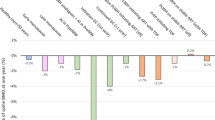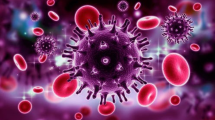Abstract
Introduction
Vitamin D receptor (VDR) gene polymorphisms in the 5′ regulatory region (Cdx2 and A-1012G), coding region (FokI), and 3′ untranslated region (UTR; BsmI, ApaI, and TaqI) were studied to find out whether these polymorphisms are associated with susceptibility to or protection against HIV-1 and development of tuberculosis (TB) in human immunodeficiency virus (HIV)-1-infected patients.
Study Subjects and Methods
The study was carried out in 131 HIV patients without TB (HIV+ TB−) and 113 HIV patients with TB (HIV+ TB+; includes 82 patients with pulmonary TB (HIV+ PTB+) and 31 with extra pulmonary TB), 108 HIV-negative pulmonary TB patients (HIV− PTB+), and 146 healthy controls.
Results
Among the 5′ regulatory and coding region polymorphisms, significantly increased frequency of G/A genotype of Cdx-2 was observed in HIV+ TB− group compared to controls (p = 0.012, odds ratio (OR) 1.89 95% confidence interval (CI) 1.14–3.15). In the 3′ UTR genotypes, a decreased frequency of b/b genotype of BsmI in total HIV patients (p = 0.014, OR 0.54 95% CI 0.32–0.89) and increased frequencies of A/A genotype of ApaI in HIV+ TB+ patients (p = 0.041, OR 1.77 95% CI 1.02–3.06) and t/t genotype of TaqI in HIV+ PTB+ patients (p = 0.05, OR 2.32 95% CI 0.99–5.46) were observed compared to controls. Haplotype analysis revealed significantly increased frequencies of 3′ UTR haplotype B-A-t in HIV+ TB+ and HIV+ PTB+ groups (Pc = 0.030, OR 1.75 95% CI 1.14–2.66) and decreased frequencies of b-A-T haplotype in total HIV patients (Pc = 0.012, OR 0.46 95% CI 0.27–0.77), HIV+ TB− (p = 0.031 OR 0.48 95% CI 0.25–0.89), and HIV+ PTB+ groups (Pc = 0.04, OR 0.47 95% CI 0.23–0.89) compared to controls.
Conclusions
The results suggest that VDR gene 3′ UTR haplotype b-A-T may be associated with protection against HIV infection while B-A-t haplotype might be associated with susceptibility to development of TB in HIV-1-infected patients.

Similar content being viewed by others
References
Whalen C, Horsburgh CR, Hom D, Lahart C, Simberkoff M, Ellner J. Accelerated course of human immunodeficiency virus infection after tuberculosis. Am J Respir Crit Care Med. 1995;151:129–35.
O’Brien SJ, Nelson GW. Human genes that limit AIDS. Nat Genet. 2004;36:565–74. doi:10.1038/ng1369.
Narain JP, Lo YR. Epidemiology of HIV-TB in Asia. Indian J Med Res. 2004;120:277–89.
Liu PT, Stenger S, Li H, Wenzel L, Tan BH, Krutzik SR, et al. Toll-like receptor triggering of a vitamin D-mediated human antimicrobial response. Science. 2006;311:1770–3. doi:10.1126/science.1123933.
Rigby WF, Waugh M, Graziano RF. Regulation of human monocyte HLA-DR and CD4 antigen expression, and antigen presentation by 1,25-dihydroxyvitamin D3. Blood. 1990;76:189–97.
Connor RI, Rigby WF. 1 alpha, 25-dihydroxyvitamin D3 inhibits productive infection of human monocytes by HIV-1. Biochem Biophys Res Commun. 1991;176:852–9. doi:10.1016/S0006-291X(05)80264-5.
Nevado J, Tenbaum SP, Castillo AI, Sanchez-Pacheco A, Aranda A. Activation of the human immunodeficiency virus type I long terminal repeat by 1alpha, 25-dihydroxyvitamin D3. J Mol Endocrinol. 2007;38:587–601. doi:10.1677/JME-06-0065.
Fang Y, van Meurs JB, d’Alesio A, Jhamai M, Zhao H, Rivadeneira F, et al. Promoter and 3¢-untranslated-region haplotypes in the vitamin d receptor gene predispose to osteoporotic fracture: the Rotterdam study. Am J Hum Genet. 2005;77:807–23. doi:10.1086/497438.
Uitterlinden AG, Fang Y, Van Meurs JB, Pols HA, Van Leeuwen JP. Genetics and biology of vitamin D receptor polymorphisms. Gene. 2004;338:143–56. doi:10.1016/j.gene.2004.05.014.
Barber Y, Rubio C, Fernandez E, Rubio M, Fibla J. Host genetic background at CCR5 chemokine receptor and vitamin D receptor loci and human immunodeficiency virus (HIV) type 1 disease progression among HIV-seropositive injection drug users. J Infect Dis. 2001;184:1279–88. doi:10.1086/324000.
Nieto G, Barber Y, Rubio MC, Rubio M, Fibla J. Association between AIDS disease progression rates and the Fok-I polymorphism of the VDR gene in a cohort of HIV-1 seropositive patients. J Steroid Biochem Mol Biol 2004;89–90:199–207. doi:10.1016/j.jsbmb.2004.03.086.
de la Torre MS, Torres C, Nieto G, Vergara S, Carrero AJ, Macias J, et al. Vitamin D receptor gene haplotypes and susceptibility to HIV-1 infection in injection drug users. J Infect Dis. 2008;197:405–10. doi:10.1086/525043.
Selvaraj P, Narayanan PR, Reetha AM. Association of vitamin D receptor genotypes with the susceptibility to pulmonary tuberculosis in female patients and resistance in female contacts. Indian J Med Res. 2000;111:172–9.
Selvaraj P, Chandra G, Kurian SM, Reetha AM, Narayanan PR. Association of vitamin D receptor gene variants of Bsm I, Apa I and Fok I polymorphisms with susceptibility or resistance to pulmonary tuberculosis. Curr Sci. 2003;84:1564–8.
Bornman L, Campbell SJ, Fielding K, Bah B, Sillah J, Gustafson P, et al. Vitamin D receptor polymorphisms and susceptibility to tuberculosis in West Africa: a case-control and family study. J Infect Dis. 2004;190:1631–41. doi:10.1086/424462.
Lombard Z, Dalton DL, Venter PA, Williams RC, Bornman L. Association of HLA-DR, -DQ, and vitamin D receptor alleles and haplotypes with tuberculosis in the Venda of South Africa. Hum Immunol. 2006;67:643–54. doi:10.1016/j.humimm.2006.04.008.
Wilbur AK, Kubatko LS, Hurtado AM, Hill KR, Stone AC. Vitamin D receptor gene polymorphisms and susceptibility M. tuberculosis in native Paraguayans. Tuberculosis (Edinb) 2007;87:329–37. doi:10.1016/j.tube.2007.01.001.
Selvaraj P, Alagarasu K, Harishankar M, Vidyarani M, Narayanan PR. Regulatory region polymorphisms of vitamin D receptor gene in pulmonary tuberculosis patients and normal healthy subjects of south India. Int J Immunogenet. 2008;35:251–4. doi:10.1111/j.1744-313X.2008.00764.x.
Alagarasu K, Selvaraj P, Swaminathan S, Raghavan S, Narendran G, Narayanan PR. Mannose binding lectin gene variants and susceptibility to tuberculosis in HIV-1 infected patients of South India. Tuberculosis (Edinb). 2007;87:535–43. doi:10.1016/j.tube.2007.07.007.
Fang Y, van Meurs JB, Bergink AP, Hofman A, van Duijn CM, van Leeuwen JP, et al. Cdx-2 polymorphism in the promoter region of the human vitamin D receptor gene determines susceptibility to fracture in the elderly. J Bone Miner Res. 2003;18:1632–41. doi:10.1359/jbmr.2003.18.9.1632.
Pani MA, Knapp M, Donner H, Braun J, Baur MP, Usadel KH, et al. Vitamin D receptor allele combinations influence genetic susceptibility to type 1 diabetes in Germans. Diabetes. 2000;49:504–7. doi:10.2337/diabetes.49.3.504.
Halsall JA, Osborne JE, Potter L, Pringle JH, Hutchinson PE. A novel polymorphism in the 1A promoter region of the vitamin D receptor is associated with altered susceptibility and prognosis in malignant melanoma. Br J Cancer. 2004;91:765–70.
Barrett JC, Fry B, Maller J, Daly MJ. Haploview: analysis and visualization of LD and haplotype maps. Bioinformatics. 2005;21:263–5. doi:10.1093/bioinformatics/bth457.
Purcell S, Neale B, Todd-Brown K, Thomas L, Ferreira MA, Bender D, et al. PLINK: a tool set for whole-genome association and population-based linkage analyses. Am J Hum Genet. 2007;81:559–75. doi:10.1086/519795.
Selvaraj P, Chandra G, Jawahar MS, Rani MV, Rajeshwari DN, Narayanan PR. Regulatory role of vitamin D receptor gene variants of Bsm I, Apa I, Taq I, and Fok I polymorphisms on macrophage phagocytosis and lymphoproliferative response to Mycobacterium tuberculosis antigen in pulmonary tuberculosis. J Clin Immunol. 2004;24:523–32. doi:10.1023/B:JOCI.0000040923.07879.31.
Selvaraj P, Vidyarani M, Alagarasu K, Prabhu Anand S, Narayanan PR. Regulatory role of promoter and 3’ UTR variants of vitamin D receptor gene on cytokine response in pulmonary tuberculosis. J Clin Immunol 2008;28:306–13. doi:10.1007/s10875-007-9152-5.
Kollmann TR, Pettoello-Mantovani M, Katopodis NF, Hachamovitch M, Rubinstein A, Kim A, et al. Inhibition of acute in vivo human immunodeficiency virus infection by human interleukin 10 treatment of SCID mice implanted with human fetal thymus and liver. Proc Natl Acad Sci U S A. 1996;93:3126–31. doi:10.1073/pnas.93.7.3126.
Shin HD, Winkler C, Stephens JC, Bream J, Young H, Goedert JJ, et al. Genetic restriction of HIV-1 pathogenesis to AIDS by promoter alleles of IL10. Proc Natl Acad Sci U S A. 2000;97:14467–72. doi:10.1073/pnas.97.26.14467.
Bergman P, Walter-Jallow L, Broliden K, Agerberth B, Soderlund J. The antimicrobial peptide LL-37 inhibits HIV-1 replication. Curr HIV Res. 2007;5:410–5. doi:10.2174/157016207781023947.
Holmes CB, Wood R, Badri M, Zilber S, Wang B, Maartens G, et al. CD4 decline and incidence of opportunistic infections in Cape Town, South Africa: implications for prophylaxis and treatment. J Acquir Immune Defic Syndr. 2006;42:464–9. doi:10.1097/01.qai.0000225729.79610.b7.
Acknowledgements
This work was financially supported by Indian Council of Medical Research, New Delhi under HIV–TB Task force program, Project No.: 2003-05490. We also acknowledge the Indian Council of Medical Research, New Delhi for providing senior research fellowship to Mr. K. Alagarasu. We thank Ms. J. Chitra for the technical help rendered by her. We are indebted to all the patients and healthy volunteers who participated in the study.
Author information
Authors and Affiliations
Corresponding author
Rights and permissions
About this article
Cite this article
Alagarasu, K., Selvaraj, P., Swaminathan, S. et al. 5′ Regulatory and 3′ Untranslated Region Polymorphisms of Vitamin D Receptor Gene in South Indian HIV and HIV–TB Patients. J Clin Immunol 29, 196–204 (2009). https://doi.org/10.1007/s10875-008-9234-z
Received:
Accepted:
Published:
Issue Date:
DOI: https://doi.org/10.1007/s10875-008-9234-z




